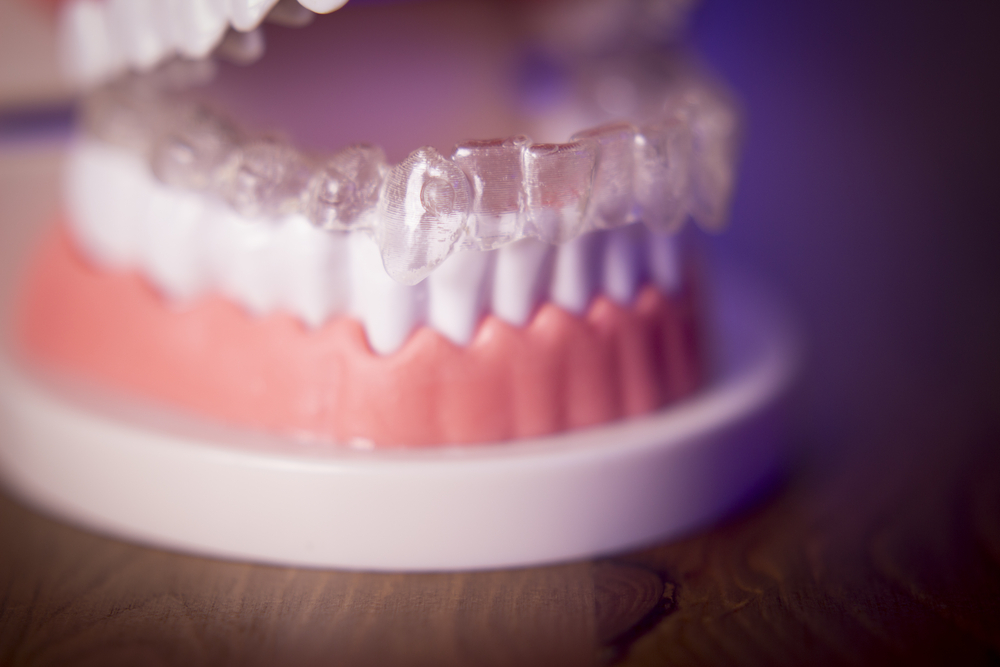Lingual Braces vs. Invisalign: Which Is Better?

As modern technology has advanced, so have the opportunities to straighten teeth in a multitude of ways. Because of this, lingual braces and Invisalign have become popular options for orthodontic care due to their discretion and near-invisibility. While lingual braces have brackets and wires attached to the backside of the teeth, Invisalign offers braces-free care with the use of clear, removable aligners. Both options have their pros and cons, and should be chosen upon an individual’s needs and wants. Find out whether lingual braces or Invisalign is the best option for your orthodontic needs with this guide!
What Are Lingual Braces?
Millions of teenagers and adults have braces put on each year, and most pick the traditional metal braces that we’re all so used to seeing. However, traditional braces can be bulky, annoying and embarrassing for teenagers and adults alike, and many patients feel like they’re distracting. Lingual braces are another option for patients who prefer invisible treatment over big, bulky braces, plus they can achieve the same straight, beautiful teeth that other treatments provide. Instead of wearing braces on the outside of teeth, lingual braces attach the brackets and wires to the backside (lingual side) of teeth for an inconspicuous and nearly-invisible treatment. Other than aesthetic concerns, patients opt in for lingual braces as they make it easier to play wind instruments, such as the flute or tuba, and they’re more functional for athletes that play contact sports. However, not every orthodontic office offers lingual braces; orthodontists have to complete specialized training to be able to install lingual braces, so you’ll have to do your research to find out who in your area is qualified to perform treatment.
Additionally, lingual braces can take longer to get used to since they’re on the backside of your teeth, close to your tongue. They can make swallowing more difficult as the tongue can’t thrust between your teeth as easily as it could before. Patients also have to have long enough teeth to provide enough room for the braces to be glued onto them, so children and those with small teeth typically don’t qualify for this type of treatment. Lastly, treatment time is usually longer with lingual braces than traditional braces. The entire process depends on your orthodontist and how well you take care of your teeth during treatment, so treatment time varies from patient to patient.
How Invisalign Works
Another option for patients who prefer invisible orthodontic care is Invisalign, which uses clear, removable aligners to fix malocclusion over a period of several months or years. Some patients highly dislike the look of metal braces, lingual or not, and Invisalign offers them the care they need without having to sacrifice their confidence at work or social events. Many enjoy Invisalign because its unique treatment allows them to remove their orthodontic device during eating, drinking, flossing and brushing, making these daily activities much more manageable. They let you eat all of your favorite foods, you can’t break a wire or bracket, oral hygiene isn’t hindered and they’re virtually invisible.
Wearing Invisalign retainers does take time, effort and patience, however. One aligner is worn for one to two weeks before replacing it with the next one in line. You’ll have a checkup every six to eight weeks to monitor your teeth and receive a new batch of aligners to wear for the next several weeks. During this time, Invisalign aligners need to be worn for 20-22 hours of the day, which is a huge commitment for busy people. Aligners also need to be carefully washed and cleaned with a toothbrush each night to keep bacteria from growing. Since they’re removable, Invisalign aligners can be easily lost, misplaced or broken by a fall or child, so extreme care will be necessary to keep them intact.
Making A Choice
Both lingual braces and Invisalign are viable options for patients who want orthodontic care that is undetectable and discreet, but whichever you choose is up to you and your orthodontic needs. The first step that you’ll need to take is to visit with your orthodontist for an evaluation of your teeth and to discuss which of the two would work best for your wants and needs, plus the orthodontist’s recommendation. Remember that while Invisalign is a great option for those who want to take their orthodontic care into their own hands, it requires extreme responsibility and care for the aligners you’ll be using. Lingual braces, on the other hand, will always remain in your mouth, so you won’t need to worry about losing anything like you do with Invisalign, but flossing and brushing can be more difficult as you’ll have to do it all from the backside of your teeth. Your choice should be based on what you are willing and not willing to do during treatment, so do your research on both options to be fully informed on what to expect.
Schedule Your Consultation
To be evaluated for lingual braces or Invisalign, call Belmar Orthodontics at (303) 225-9016 to schedule a consultation. Our team is qualified and experienced at installing both lingual braces and Invisalign, plus we can give you extra tips on how to keep your teeth brilliant and healthy during treatment. Call today to start your journey to a more beautiful smile!
How Invisalign Can Increase Teens’ Confidence

While many teenagers need orthodontic care, some don’t like how traditional braces make them look or feel. With advances in modern technology and appliances that have been developed, teenagers have more options than ever to straighten their teeth without having to lose their confidence. Invisalign Teen offers the same benefits as traditional braces, but with the ability to use a clear, removable aligner. While nearly undetectable, teenagers will be able to get straight teeth without anyone knowing. Learn how Invisalign works and how your teenager can benefit from its groundbreaking system!
What Is Invisalign Teen?
Most teens will need orthodontic care, but many don’t like the look of traditional braces. Luckily, modern advances in orthodontic technology have created other options for them, such as Invisalign Teen, that allows kids to get straight teeth in one of the most discreet ways possible. Invisalign Teen eliminates the need for metal braces and brackets by replacing them with clear, removable aligners. Clear aligners work just as effectively as traditional braces but without the self-consciousness that metal braces typically bring. Before treatment begins, however, your teen will need an examination by their orthodontist and have diagnostic X-rays and impressions (molds) taken of their teeth. Crowded teeth and/or wisdom teeth may need to be removed before treatment begins so that the aligners can fit properly in the mouth. The orthodontist will then create a set of aligners that your child will wear, one after another, for the space of one to two years. These aligners will straighten their teeth over time, and each aligner will be replaced with another one as teeth begin shifting into proper alignment. Most patients will be required to wear their aligners anywhere from 20-22 hours per day, so your teen will need to be careful and consistent during their time with Invisalign.
Invisalign Teen offers many benefits other than invisible treatment. With Invisalign, your teen won’t have to sacrifice their favorite foods that tend to get stuck in traditional braces; all they need to do is remove the aligner to eat and drink, and they’re good to go. Your kid will also be able to continue playing the sports and activities that they love, and they’ll have less emergency visits since there are no wires or brackets that can break. Invisalign allows kids to use a mouthguard when playing sports and continue playing their instrument because it is removable. With Invisalign, your child will have newfound freedom that other orthodontic treatment can’t provide.
Taking Care of Invisalign Aligners
As with any other orthodontic appliance, your child will need to take strict care of their Invisalign aligners to keep them clean and free from damage. After they remove their aligner to eat or drink, it’s important that they brush their teeth before putting the aligner back in to prevent bacteria from building up on their teeth, which can lead to tooth decay. Additionally, your teen needs to brush their aligner each night before bed to keep them fresh and clean. Your teen will most likely be wearing their aligner for one to two weeks at a time, with a checkup every six to eight weeks to pick up their new aligner, so it’s essential that they keep their aligners in a safe place during that time. Aligners can break when dropped or can be damaged by pets or little siblings, so proper storage whenever they’re not being used will keep any accidents from happening.
Importance of Good Oral Hygiene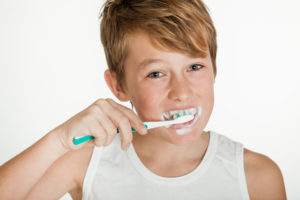
Having a good oral hygiene regimen will protect your child’s teeth from disease and keep their treatment plan on track. If teeth aren’t taken care of, orthodontic care can be slowed down as the orthodontist will have to address their cavities or tooth decay before treatment can continue. Brushing and flossing are essential before, during and after orthodontic care to keep teeth healthy and strong. Make sure that your teen is brushing with a fluoride toothpaste to strengthen their tooth enamel. Consistent flossing will also keep teeth decay-free by removing food particles that can get stuck and allow bacteria to grow. Additionally, using a fluoride mouthwash can aid brushing and flossing by adding the extra punch that teeth need to fight plaque and decay.
Scheduling A Consultation
If your teen would benefit from Invisalign, call Belmar Orthodontics today at (303) 225-9016! Our team of dedicated professionals is experienced with fitting Invisalign Teen and helping your child feel comfortable and satisfied during orthodontic treatment. Call today to begin your teen’s treatment for a beautiful, confident smile!
Perks of Lingual Braces

As modern technology has improved the tools and appliances that are now used in orthodontic offices, there are more options than ever for patients to get straighter teeth without the look of traditional metal braces. Lingual braces are an ideal option for patients who want orthodontic care but in the most discreet way possible. By using a hidden apparatus on the tongue-side of your teeth, you can get straight, beautiful teeth without sacrificing your confidence. Find out what other perks lingual braces have and what treatment looks like with this guide!
What Are Lingual Braces?
Braces have come a long way since they were first invented, and patients have more options than ever to get the straight teeth they want without sacrificing their confidence. Traditionally, metal braces were the most common type of orthodontic appliance used but were bulky and aesthetically not very pleasing. With the modern technology that has been developed during the last few decades, one type of braces in particular has become more and more common. Lingual braces are an alternative to traditional metal braces and provide utmost discretion as they are almost completely hidden. Unlike traditional braces whose brackets are attached to the front of the teeth, lingual braces are attached to the back side (tongue-side) of teeth, making them practically hidden from view. Fortunately, lingual braces can provide the same results as traditional braces but in a manner that is nearly undetectable. These braces are particularly helpful for patients, especially teenagers, who think braces are unattractive or distracting. Now, more than ever, patients can receive the orthodontic treatment they need without putting it off for aesthetic reasons.
How Lingual Braces Differ From Other Options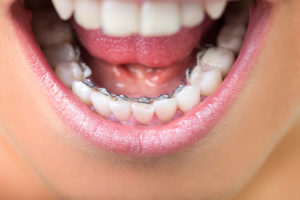
While the obvious advantage of choosing lingual braces over other orthodontic appliances deals with the invisibility of the braces themselves, there are other reasons why lingual braces might be the best option for you. Since their invention in the 1980s, lingual braces have slowly gained recognition as a viable option for orthodontic treatment. In fact, very few dentists even offer this technique because special training is needed to perform it. You will still need X-rays, molds and impressions of your teeth to begin treatment, just like you would when getting any other orthodontic treatment. The process is relatively easy to install them, as the brackets are glued to the lingual side of the teeth with a wire and elastics (if needed) to help move the teeth into position. Lingual braces are always on during treatment, so they are constantly shifting your teeth into the correct position without you or others noticing. A similar treatment to lingual braces is called Invisalign, which uses a removable aligner to straighten teeth. Invisalign is a popular option because the aligner is clear and removable so most people don’t notice it’s there, but not everyone is eligible for Invisalign. While Invisalign is a great option, lingual braces tend to be more helpful for patients with specific concerns. Athletes benefit greatly from lingual braces as it helps prevent mouth injuries since the brackets aren’t on the front of the teeth. Musicians, like those who play a wind instrument (flute, trumpet, clarinet, etc.), are also common wearers of lingual braces as they tend to not get in the way as much when playing. Lastly, those patients who don’t qualify for Invisalign typically choose lingual braces as it is the second most discreet option available. Depending on your needs and your orthodontist’s recommendation, you can choose which option you would like to get the beautiful teeth that you want, in the way that you want.
How To Begin Treatment
As mentioned previously, you must be eligible for certain types of orthodontic treatment to receive them. If you are interested in lingual braces, you will first need to visit with your orthodontist to have a consultation and evaluation to determine whether lingual braces are your best option. If you are a candidate, you will have impressions taken of your teeth which will be sent to a lab to create your custom-made brackets and wires. Afterwards, the brackets and wires will be bonded to your teeth to begin treatment. It is important to note that while lingual braces are a great way to keep your treatment unnoticed by others, the braces themselves are more difficult to clean since you can’t see them. For this reason, it is extremely important to clean your teeth thoroughly each day because it will be easier for food to get stuck and bacteria to grow in areas that are hard to see or reach. Another reason why it is important to consult with your orthodontist before choosing lingual braces is the price. Traditional braces typically range from $3,000-7,000, but lingual braces can be anywhere from $8,000-10,000. For patients who are on a budget, this is something to consider as you are in the decision-making process. Check with your dental insurance to see how much they can cover for orthodontic treatment. While many plans don’t offer coverage for adults over 18, many do partially cover children under 18. How much coverage will depend on your provider, so make sure to contact your insurance company for figures and amounts before you or your child begins treatment.
Get Started Today
At Belmar Orthodontics, our team is certified and trained for installing lingual braces. We are ready to help you and your family get the smile you deserve in a way that is most comfortable for you. For a consultation about lingual braces or more information about orthodontic treatment options, call our office at (303) 225-9016. Your journey to a healthier smile starts today, so call now!
Signs That You Might Need Braces
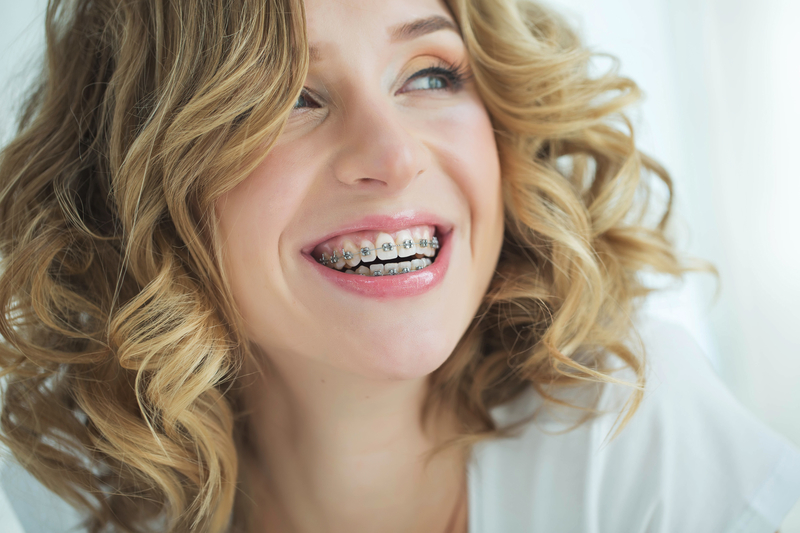
For many patients, getting braces is a big decision that affects oral health. How do you know whether you or your child needs braces, though? Some symptoms are obvious: misplaced or crowded teeth, or teeth that don’t meet normally. Other signs that you need braces are more inconspicuous, though, such as biting the cheek or a jaw that pops or shifts. While some of these symptoms are more serious than others, orthodontic care is the way to go to alleviate pain and correct any underlying issues. Learn about what signs you should be looking for to decide if braces are right for you with these tips!
What To Look Out For
As our teeth begin to erupt at a young age, they can fill into improper spaces or cause problems with adjacent teeth. Crooked or misaligned teeth aesthetically aren’t very pleasing for people, and most patients end up receiving orthodontic treatment during some point in their lives. Orthodontic problems don’t always mean crooked teeth, though. While there are some obvious signs that you might benefit from orthodontics, such as crowded teeth or an underbite/overbite, there are other symptoms that are less noticeable but equally as undesirable. The American Association of Orthodontics recommends that children have their first orthodontic visit between the ages of 7 and 8, but if certain complications are present, your child does not and should not wait until that age to be seen. If you have a young child, look for some of the following symptoms that warrant orthodontic care:
- Thumb or finger sucking
- Early, late or irregular loss of baby teeth
- Difficulty in chewing or biting
As children age, orthodontic problems will begin to show themselves, but some don’t appear until adulthood. No matter your age or prior orthodontic care, there are other symptoms that indicate a problem and should be addressed by an orthodontist. If you are struggling with a popping jaw, have to breathe through your mouth on a regular basis, are constantly biting your cheeks, and/or noticing teeth or jaws that are out of proportion to the rest of your face, you should have an orthodontic consultation. While many of these symptoms seem harmless or aren’t very noticeable, they can have long-term consequences that can negatively affect your oral health. Braces can remedy these issues so that your oral health isn’t compromised. It’s never too late for you to take charge of your oral health and get the smile that you deserve!
Advantages of Early Orthodontics
Not all kids will need orthodontic care, but many will. Meeting with your child’s dentist early on will help them determine whether your child would benefit from orthodontic treatment. If you have a child who needs an orthodontic issue remedied, there are certain advantages that come after receiving braces. Having your child evaluated by an orthodontist can help he/she observe the progress of incoming teeth, guide teeth into their ideal positions, monitor face and jaw development, detect hidden dental issues and reduce the risk of impacted teeth. For young children, orthodontic visits can sometimes be scary. Nonetheless, child orthodontic visits are simple and non-intrusive, so as to keep your child comfortable and happy. At Belmar Orthodontics, we do our best to give your child the care they need while making sure that their fears and questions are addressed. For adolescents, our options at include aesthetically-minded treatment options that will help your teen feel less self-conscious about braces. Braces can sometimes be seen as “dorky” or “uncool” for teens, but the list of options your teenager can choose from will give them plenty of choices to get straight teeth while still looking cool. Good oral health habits are started at a young age, and bringing your child in to see the orthodontist will help them establish those habits that will last a lifetime.
How You Can Benefit From Adult Orthodontics
Against popular belief, braces and orthodontic care aren’t just for kids and teenagers! In fact, one in five orthodontic patients is an adult; in just the U.S. and Canada alone, more than a million orthodontic patients are adults! You, as an adult, can benefit from the same care that young patients do and fix the orthodontic problems that you’ve been suffering from since childhood. As long as your teeth are healthy, you can receive orthodontic treatment at any age. The most common benefits of adult orthodontics include the following:
- More discreet treatment methods
- Correction of lifetime dental issues
- Faster treatment time than previous treatments
- Increased confidence and self-esteem
It’s important to note, however, that any previous orthodontic problems, such as periodontal disease or decayed/missing teeth, will need to be addressed before an orthodontic appliance can be placed. Once those issues are fixed, you’ll be fitted with braces and can continue your life just as usual. If you so choose, you can even opt in for hidden lingual braces or Invisalign clear, which will get you the straight teeth that you want while being completely unnoticeable. Speak with your orthodontist to determine which braces would be best for your needs before making any decisions.
Staying On Top Of Your Oral Health
Before any patient can receive orthodontic treatment, the health of their teeth, gums and mouth will first be evaluated. For this reason, it is important that children and adults alike are brushing twice a day and flossing on a nightly basis. The foods we eat also affects our oral health, as well. Especially during orthodontic treatment, certain foods, like sticky or sugary candies and food, can damage orthodontic appliances and make it easier for tooth decay to develop as plaque builds up on teeth. Brushing and flossing will partly diminish the effects of these foods, but not entirely. Make sure that you and your children are eating a healthy diet with minimal sugary snacks to avoid dental complications during treatment.
To ensure good oral health during and after orthodontic treatment, schedule an appointment with Belmar Orthodontics at (303) 225-9016 for a consultation.
Does Your Child Really Need Braces?

We typically get our braces put on during our teenage to adult years, but how do you know whether your young child should have braces or not? Child orthodontics is a common practice for those children struggling with crooked, overlapping, or overcrowded teeth, or a misaligned jaw. There are many advantages for children as they receive braces earlier on in life as it can prevent future orthodontic treatment and guide incoming teeth into the proper position. Learn how to recognize whether your child needs braces through these tips!
When To Start
Young kids go through a lot of physical changes during adolescence, and some of those changes include jaw and teeth development. Orthodontics has become more and more common in young children to adjust certain orthodontic issues that occasionally occur as a child develops. Traditionally, orthodontic treatment begins once a child has lost most of their baby (primary) teeth and a majority of their permanent teeth have grown in, which typically occurs between the ages of 8 and 14. Even though braces is recommended at this age, it is a good idea to get an orthodontic evaluation for your child by the time they turn 7 years old; at this age, an orthodontist is able to detect early symptoms of orthodontic problems, such as an underbite or crossbite, which can cause severe complications and more treatment later on if left untreated at an early age. Bones are still growing during this age, so it is an ideal time to meet with an orthodontist to monitor bone and jaw development while evaluating any apparent orthodontic issues.
Advantages of Child Orthodontics
Although child orthodontics is only necessary if there are physical developmental issues within the mouth, receiving orthodontic treatment as a child has certain advantages. Visiting an orthodontist at an early age allows for observation of incoming teeth and reduces the risk of impacted teeth as your child loses their baby teeth and their permanent teeth take their place. As the orthodontist monitors your child’s teeth, they can help guide their teeth into the correct position as soon as they begin erupting, usually through braces or other orthodontic devices that help move teeth into the correct positions. Regular orthodontic visits also decrease the risk of hidden dental issues and permanent tooth extractions, as it allows for the orthodontist to adjust the jaw so that teeth crowding doesn’t occur.
Child orthodontics doesn’t always imply braces. Since a child’s jaw and teeth are still growing, many orthodontic issues, such as crowding, can be addressed before complications occur later on during adolescence. In this case, orthodontic treatment in young children is known as interceptive orthodontics. Many times, a child’s dental arch may be too small to fit all of their teeth. Just a few decades ago, it was a common practice to simply remove some permanent teeth to make space in the mouth. Now, though, child orthodontics can avoid this through the use of a palatal expander that expands the child’s upper dental arch, which allows adult teeth to emerge in a better position. Interceptive orthodontics can speed up the process of aligning teeth into the proper position and cause future treatment to be shorter and less involved.
How Much Does It Cost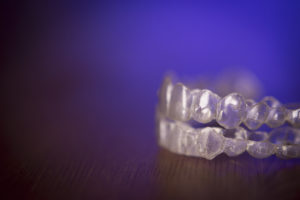
If braces are fit too early on a child, treatment can take longer and be more expensive. For this reason, it’s important to have regular orthodontic visits to monitor tooth and jaw development to ensure that whenever your child receives braces, it’s at the correct time. The braces that your orthodontist recommends will depend on your child’s type of problem that he or she has. There are three types of braces that most children will receive, and they each have different advantages and disadvantages:
- Traditional metal braces – Have steel ties holding the wires between the brackets in place. Cost is driven by what your orthodontist will charge for treatment, including multiple office visits.
- Damon braces – Do not have steel ties, but the brackets themselves hold the wires in place. Typically more expensive and can cost up to $8,000, but you pay for less dental appointments since the braces are self-ligating.
- Invisalign (or other clear or removable aligners) – Fit over the child’s teeth similar to a mouthguard. Your child will receive a number of aligners during the duration of their treatment, so cost is determined by the amount of aligners needed to achieve correction.
Just like adult orthodontics, child orthodontics can cost anywhere between $3,000 and $8,000, depending on what level of correction your child needs. If your child needs to have teeth extracted or be fitted for other appliances, the cost will most likely go up, as well. The way your child complies to orthodontic treatment will also affect the cost. Make sure that they are brushing and flossing everyday so as to avoid tooth decay, which will increase the cost of treatment as your dentist will have to treat around the braces to fix the decay.
Is It Necessary?
As mentioned before, whether your child needs braces or not at an earlier age is dependent upon their mouth structure and how their teeth form. For more information about child orthodontics or if you’re interested in scheduling a consultation, contact Belmar Orthodontics at (303) 225-9016!. Our experienced and highly trained orthodontic staff offers a variety of orthodontic treatments and technology so that you can be confident your children are receiving the best care available.
Orthodontic Treatment as Restorative Dentistry

Did you know that getting your teeth straightened can be a form of restorative dentistry? This is because restorative dentistry seeks to restore or bring your smile to a more perfect state. Crooked teeth can become straight, which in turn starts to relieve the burdens of tooth decay, gum disease, bad breath and other oral health problems. If you want to restore your smile once more, see what our 4 different orthodontic options can do for you!
Why Is Your Smile Important?
Some patients don’t realize just how important a smile really is. Studies show that your smile is one of the first things another person will notice about you. Is that smile showing that you are healthy and confident? Or do you hide your smile because of crooked teeth, discoloration or other aspects you don’t like? When a smile looks good, studies show that people often feel more confident and they exude that confidence much easier. A better smile can lead a person to be more social and confident to pursue successful endeavors.
It’s not only what a smile does for a person themself that’s important. How your smile looks to others also will determine a lot about how successful you are. The makes of the orthodontic appliance Invisalign conducted a study about smiles, and what they found was quite amazing:
- 1/3rd of people notice a person’s smile before any other feature.
- Those who have a straighter, more beautiful smile are 45% more likely to get a job over a competitor with a crooked or discolored smile.
- Your smile can send messages about how healthy you are and how happy you seem. When that smile is straighter and more beautiful, others will see you as 21% more likely to be healthier and 47% happier.
- 73% of people are more likely to trust you at first glance if you have a better smile.
- You’re 58% more likely to be perceived as wealthy and 57% more likely to get a date if you have a great smile.

What Is Restorative Dentistry?
Your teeth will determine most of how good your oral health. When you eat, sugars in the food you eat mix with mouth bacteria. That creates plaque, or that sticky, acidic substance that coats your teeth. Over time, if proper oral hygiene habits aren’t observed, the teeth will change colors and decay. This happens much easier to the teeth if they are crooked. That’s because it’s harder to clean between the teeth if there is no way to get floss through crooked teeth.
Restorative dentistry seeks to restore smiles that are crooked or damaged through decay or gum disease (a disease to the gums that happens just like tooth decay). This form of dentistry consists of dental services such as teeth whitening, same-day crowns, root canal therapy and tooth-colored fillings. There are many dental patients that will get dental veneers—also known as “porcelain veneers”—to restore their smile. This is a dental service where the top layer of your teeth is taken off and replaced with a perfect, white tooth shell. However, once that part of your natural tooth is taken off, you can’t get that natural part back. Porcelain veneers do make your smile look beautiful, but they don’t change your crooked teeth or oral health issues underneath.
Fixing the Problem with Orthodontic Treatment
Fixing the problem permanently is a great solution to getting a beautiful smile and reducing your problems with tooth decay, gum disease, bad breath and more. Straighter smiles are ones that are easier to clean and ones that look attractive and healthy. Plus, once you straighten your smile with orthodontic treatment, it can stay that way for life. Orthodontics is different than dentistry, but is absolutely important to your oral health.
Dentists will fix problems with tooth decay and gum disease. Orthodontic treatment and restorative dentistry through those braces can help prevent problems in the first place. Plus, orthodontic braces are able to correct bite and alignment issues that are caused by misaligned bites and jaws. Those issues can cause speech and development problems without intervention. Without orthodontic treatment, other restorative dentistry methods can only do so much.
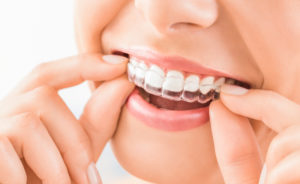
Restorative Dentistry for You
Our easiest method of restorative dentistry for teens and adults is through Invisalign treatment. This option works just as well as our lingual braces, ceramic braces and traditional metal braces. However, with Invisalign, the focus is on aesthetics as well as straightening. We want you to have a beautiful smile as you straighten, and Invisalign is a great way to achieve that.
Invisalign is a orthodontic treatment that is designed to be virtually unnoticeable on your teeth. Patients have their teeth digitally scanned in-office and a treatment plan is made for them, mapping out how orthodontic treatment will transform their smile in 18 months or less. Often, patients can straighten their smile in 1/3rd of that time, depending on the condition of the teeth, bite and alignment. Less office visits are typically needed for this type of restorative dentistry.
You simply wear your aligners for 20-22 hours each day (and overnight), and by switching out the aligners each week, your teeth shift into a straight smile over time. The benefit of this restorative dentistry option is that you are actually fixing the root cause of oral health problems. Crooked teeth cause tooth decay and gum disease to worsen, but you avoid that with a straight smile. With other restorative dentistry options (such as teeth whitening or veneers), you will still have the crooked teeth (although masked), and possibly the dental problems. Avoid all that while still getting a beautiful smile with Invisalign. If you want to learn more about this restorative dentistry option for adults and teens, contact Belmar Orthodontics today at (303) 225-9016!
5 Advantages of Invisalign Treatment
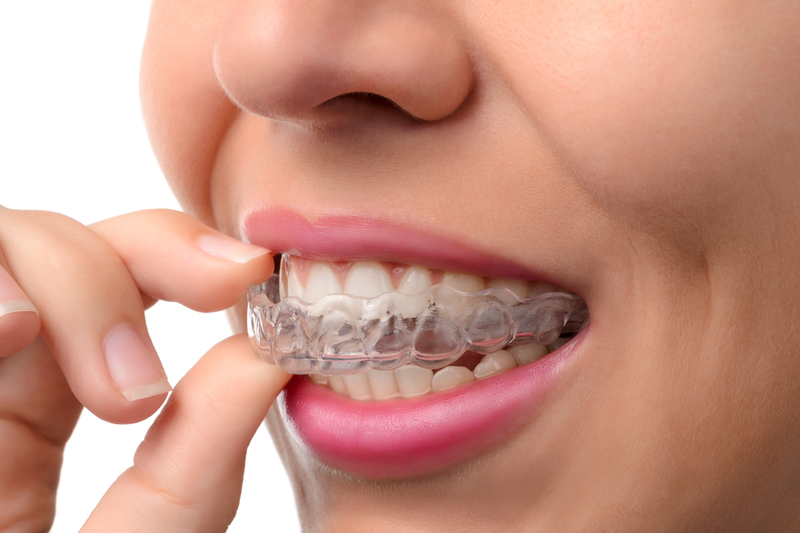
Are you thinking about straightening your teeth? A straighter smile through Invisalign treatment or other orthodontic options will set you on a path to more confidence and success. Lakewood Invisalign treatment not only works to improve your smile, but it also comes with amazing advantages over traditional braces. Not only is invisalign treatment virtually invisible on your teeth, but the aligners are easy to remove and work well with your lifestyle. Read on for more advantages of Invisalign treatment!
Invisalign and Invisalign Teen
You may have heard of Invisalign treatment before. This type of orthodontic treatment has been around for about 20 years, but has continually gained popularity—especially among adults and teenagers. We offer an alternative to traditional metal braces that can discreetly straighten your teeth while improving the functionality of your smile. Invisalign does all this without anyone knowing that you are even straightening your teeth!
Invisalign is a series of transparent aligners that gently move your teeth into a straighter position. You meet with us for an Invisalign consultation and we are able to take digital images of your teeth. With these, we make a model of your mouth and plan out a trajectory of your straightening treatment. Based off of your mouth, we design transparent aligners that will be switched out every 1-2 weeks. You wear these aligners throughout the day and night to move your teeth into that beautiful straight smile you’ve always wanted. They can even correct bite and malocclusion problems.
Advantages of Invisalign
There are many advantages to Invisalign treatment, which is why our patients love this option!
- It’s designed to be virtually unnoticeable on your teeth. The aligners are clear and fit snug to your teeth, meaning no one will know you’re wearing them.
- The aligners can easily be removed during eating, drinking, flossing and brushing. You can’t do that with any other braces option, as all the other options are cemented to your teeth. Being able to remove the aligners makes it so you have freedom with your treatment, especially if you need to remove the appliance to play sports.
- Less office visits are typically needed compared to traditional braces. You only need to come into the office every 4-6 weeks at a time.
- Teeth are easier to clean for optimum oral health during treatment. You simply remove the aligners at night, clean them, and clean your teeth as you normally would. Flossing is quick and easy, as are brushing your teeth. Traditional braces take much longer to clean.
- Total time for optimal results is usually shorter than metal braces treatment. If you need only slight orthodontic correction, you won’t need Invisalign treatment for very long.
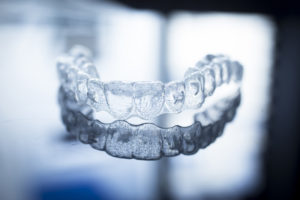
How Do the Other Options Compare?
There are various types of orthodontic options out there besides Invisalign treatment. Traditional metal braces are the most common orthodontic appliances because they are the cheapest option for straightening your teeth. These appliances involve very visible metal brackets attached to the center of each tooth with a metal archwire that passes through the brackets on top and bottom. Lingual braces are also metal braces, but they are attached to the back of your teeth. Clear braces are a very close cousin to metal braces, as they are built the same, but out of ceramic material that is white like your teeth. All options will straighten your teeth very well, but Invisalign is the most invisible option you can have. This is why adults and teens alike love Invisalign treatment so much.
You can use Invisalign treatment for simple straightening cases or complex bite and malocclusion cases. It’s invisible and you can see how your teeth move at every stage of your treatment. You can’t do that as clearly with other types of braces, but must wait until the end of treatment to see your smile. Studies also suggest that teens who do Invisalign treatment (as compared to other orthodontic methods) are 2 times more likely to have a boost in their self esteem. Who wouldn’t want that?
Your Experience with Clear Aligners
We believe that smiles are meant to be shared. However, many people with braces shy away from smiling because of the metal in their mouth. This is common with traditional metal braces, especially with adults. However, a straighter smile can do wonders for your professional and social life. Studies show that a straighter, more beautiful smile can make you more attractive to others. An amazing smile not only boosts your confidence, but can make you more successful because you feel more confident. You’ll smile more, drawing others to you and you will even be happier.
Invisalign has conducted their own research about straighter smiles and what they do for you. After orthodontic treatment, a person with a straighter smile has a leg up on their competition when it comes to landing a job. Employers are more likely to employ someone with a straighter, healthier smile because it makes them appear healthier and successful. People perceive people with straighter teeth as 58% more likely to be wealthy, 45% more successful, 47% more likely to be healthy and 38% smarter. 73% of people are also more likely to trust someone with straight teeth over someone who has crooked teeth.
Your Invisalign Treatment
If you want a straighter smile, don’t wait to get it! With the clear, removable aligners that Invisalign uses, Dr. Hardy can help you gradually move your teeth into their proper position. He can also correct malocclusion (bites that don’t close correctly), without the discomfort and presence of metal braces. When you select Invisalign to correct your smile, no one else has to know! To learn more about this braces option, call Belmar Orthodontics today at (303) 225-9016!
Get Your Braces in Time for Back-to-School

School is just around the corner and it’s time to prepare your peers for your beautiful smile. Braces not only help straighten your teeth, but they can also improve your speech, your appearance and–most importantly–your confidence! New technology gives you more options for adding a little fashion flare to your smile or straightening your teeth discreetly. Learn about all of your amazing options for braces today.
Back-To-School Success
Summer is almost over and it’s back to school time. Is your smile ready? A lot can happen over the summer and each year brings new exciting changes. Getting a straighter, more beautiful smile is something you don’t want to be without as a new year starts off. Did you know that kids with straighter teeth tend to feel more confident in school and around their peers? That confidence can help them get better grades, make more friends, and be more willing to try new opportunities. Every child and teenager alike wants to shine in their own way. You can do that and receive more confidence by getting your braces just in time for school.
In the past, many adolescents saw braces as embarrassing or unattractive. However, studies show that children and teens are receiving braces in much larger numbers than they did in the past. Now, instead of being embarrassing, braces are seen as a luxury for many families and individuals. In times of recession, families even go without necessities to make sure their children receive braces. Braces truly are worth having because of how beneficial they are for boosting self-esteem, confidence and how you’re perceived socially. Investing in them is a great way to help a child as they start off school once more.
Options for Your Braces
We love providing options for our patients at Belmar Orthodontics! Our most popular option for braces for children and teens alike are our traditional metal braces. However, there are other options we provide as well:
- Traditional Metal Braces – This is our most economical option. Our patients love the colorful bands that they can customize their braces with. Each patient can choose a certain color they love every appointment or even do a rainbow of color if they so choose.
- Incognito Lingual Braces – This option is very similar to traditional metal braces, however the braces are worn on the tongue-side of your teeth. We make an impression of your teeth and then custom-make braces that fit the inside of your teeth perfectly. You can straighten your teeth with the perfect hidden apparatus.
- Clear Ceramic Braces – We can provide ceramic braces for our patients. These braces are similar to traditional metal braces, but they are made from ceramic material. The braces blend in with your teeth perfectly as the brackets and even the wires can be made white. Ceramic braces can also decrease demineralization that can happen with metal sometimes.
- Invisalign Teen – This is a version of Invisalign transparent aligners designed with the needs of teenagers in mind. These custom-fit aligners can correct smiles and unevenly-spaced teeth while allowing patients to continue eating, drinking, and cleaning their teeth with ease.
Cleaning At Home
Your braces are something new and exciting. However, they must have proper care to truly work wonders. Brush and floss your teeth often. We recommend brushing and flossing at least twice daily. However, with braces you may want to brush the teeth more than twice a day. After each meal would be best, as food can become trapped in the brackets very easily, where it will then sit on the teeth. Plaque is a sticky, acidic substance that you want to avoid. Plaque is made from the sugars in the food you eat that mix with the bacteria in your mouth. When food is left on the teeth, that plaque can form and begin to erode your teeth.
Not brushing and flossing enough can cause erosion and demineralization that will be obvious once the braces come off. Use special flossers to get in between the teeth sufficiently. Take care of your teeth so that your smile is beautiful and straight without blemishes when your braces come off!
Tips for Success At School
Your braces are easier to manage when you’re prepared. At school, take a mouthguard with you to gym class. You can get injured with braces when playing sports, especially contact sports. A mouthguard will help protect you and your mouth from injury. Be careful what you eat as well. Some foods can damage or break your braces and other foods can get tremendously stuck in the brackets. Some foods to avoid are anything hard, gooey, crunchy or sticky. This includes food items such as gummy bears, fruit snacks, hard candies, chips of any kind, hard vegetables, and nuts. If you really want a food (such as hard fruits and veggies), make sure to cut them up into bite-size pieces. Biting into foods can lodge them into the braces, so be careful with this.
We also have braces kits you can have or tips to make one yourself. Take a kit with you to school that has the cleaning essentials you need: mirror, toothbrush, toothpaste, floss and flossers, wax for pokey wires, etc. If you need a quick cleaning or a quick fix for a wire, you’ll be set!
Your Free Consultation
There never was a better time to straighten your smile! Braces can provide your child the boost of confidence they need to start of the school year right. If you want to schedule your child’s appointment, call our Belmar Orthodontics office today at (303) 225-9016!
Invisalign Transparent Aligners or Metal Braces?
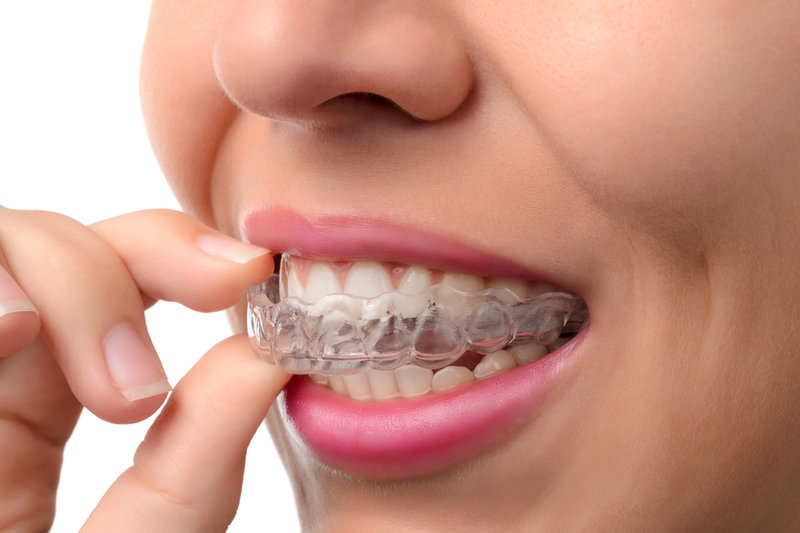
Woman wearing orthodontic silicone trainer. Invisible braces
We offer many different straightening methods at Belmar Orthodontics including Invisalign transparent aligners and traditional metal braces. In the past, traditional metal brackets were the only option for teeth straightening around. With the advancement of technology, we are now able to align the teeth with transparent aligners that work just as well as metal brackets. What are the differences between aligners and metal brackets? Which option is better for you when it comes to choosing between the two? We can answer all of your questions about Invisalign aligners and traditional metal braces and help you find the right straightening method for you.
Traditional Metal Braces
Metal braces are also known as “traditional” braces? Why? They’ve been around for decades and have proven time and time again that they work. Years ago they became the go-to option for orthodontic care and have stood the test of time. There have been tweaks here and there to make metal braces more modern, but overall, not much has changed. They are still the most popular option for braces among teenagers and the most economical choice for orthodontic care.
Metal braces consist of metal square brackets that are attached to the center of each tooth with a special type of bonding glue. This glue is strong enough that the brackets stay bonded to your teeth, but also versatile enough that the glue can be removed once treatment has come to an end. Metal braces have a thin wire that connects and goes through each bracket on the upper and lower jaw. In total, you will have two wires. These are known as “archwires” and they create an arch in your mouth that follows the natural curve of the jaw. Over time, these archwires will move the teeth into proper place so that they make the perfect, straight arch on the upper and lower jaw.
What Are Invisalign Transparent Aligners?
If you’ve looked into options for orthodontic care, you may already be familiar with Invisalign. This treatment option is a series of transparent aligners that slowly mold your teeth into proper position over time. Your doctor will scan your teeth using a digital scanning system that will then create 3D images of your teeth. You will then receive custom-made aligners made from Invisalign’s SmartTrack material. This material is transparent yet strong. The clear, removable design of these aligners renders this orthodontic treatment virtually invisible to others.
The best part is that Invisalign works well just like traditional metal braces do for shaping your smile. Simply change out your transparent aligners ever 1-2 weeks and watch how your smile changes over time. Adults and teenagers alike love this option for orthodontic care because of their ease of use Patients can eat, drink, and clean their teeth with ease. These aligners must be worn the majority of the day, but can be removed when needed for certain activities. Invisalign transparent aligners are more costly than metal braces, but you gain the benefits of easy use and cleaning, and the ability to straighten your teeth in secret.
Adult Orthodontics
Orthodontic care is not only for teenagers. About 25% of all braces wearers are adults, which is a higher percentage than it’s been in the past. Why is this? In decades and years past, people only had one choice when it came to braces: traditional metal braces. Some adults and teenagers avoid receiving braces although their smile needs them. Why? Because they don’t like the look of braces or they feel they are unattractive, distracting, or childish. Studies actually show that braces are quite the luxury to have. However, modern-day orthodontics offer treatment options everyone can be comfortable with.
Your Options
Options for orthodontic care include both traditional metal braces and Invisalign transparent aligners, but you can also choose
- Ceramic Braces – These are the same size and shape as metal braces. They function similarly to traditional metal brackets but they use ceramic brackets that are made to match the color of your teeth. Many patients love this cosmetic benefit of blending the braces to the teeth. Even the archwire can be made white! The ceramic has been shown to be much more resistant to staining and helps protect your smile from demineralization.
- Lingual Braces – Lingual braces are an amazing alternative to traditional metal braces. Lingual braces are a close cousin to metal braces. They actually look quite the same, except for the fact that the braces run along the inside of the teeth next to the tongue. You can achieve the same results as traditional orthodontics in a manner that is inconspicuous and undetectable. Dr. Hardy will make a custom mold of your teeth so that custom metal pieces can be made for each tooth back. These will then be attached snug to the inside of the tooth along with the brackets. An archwire will complete the braces and you can begin to experience the straightening power of lingual braces.
Keep Your Smile Straight
It’s never too late to correct orthodontic conditions you have. The benefits of adult orthodontics include: faster treatment time than former techniques, more discreet treatment options, correction of dental issues, increased confidence and even increased self esteem. When it comes to starting your journey to a straighter smile, we have options for you! To see if you are a great fit for ceramic braces or Incognito lingual braces, contact our Belmar Orthodontics office today at (303) 225-9016 for your free consultation. A straighter smile is just one call away!
Invisalign Treatment Questions and Answers
Learn common Invisalign treatment questions and answers so you can determine if this popular orthodontic treatment option is for you. Our friendly staff at Belmar Orthodontics can offer you excellent patient education to help you make an informed decision. To help you determine if Invisalign treatment is for you, contact our office for a consultation and evaluation.
How Invisible Are the Invisalign Aligners?
Invisalign treatment is the most invisible orthodontic option on the market right now. For patients that have employment or hobbies that require discretion, Invisalign treatment is the way to go. The Invisalign aligners are made of a clear plastic that is custom-designed to blend in with your smile. This aligner approach allows you to correct your orthodontic issues in a discreet manner. To achieve the best result possible, most patients will need small, tooth colored bumps (called attachments) on several of their teeth. These attachments are the same color as your teeth so they blend in easily.
Does Invisalign Treatment Work As Effectively as Traditional Braces?
For certain conditions, Invisalign will not be recommended because alternative forms of braces are needed. Your dentist will assess your needs and determine if your oral conditions and goals qualify you for Invisalign treatment. If you are approved as a candidate, you can be assured that your treatment will be just as effective with Invisalign as with braces. Invisalign treatment times are often shorter than treatment with traditional braces, but you still get the same stellar results.
Will Invisalign Affect How I Speak?
Traditional braces, retainers or Invisalign all have an adjustment period. During this adjustment period you may need to rework how you form certain sounds of letters with an appliance in your mouth. Following this initial adjustment period, most patients report no difficulties with speaking normally. It is not uncommon to have a slight lisp for the first few days as your mouth and tongue adjust to having the aligners in your mouth. The great thing about Invisalign is that the aligners are removable. If you have an important interview or presentation and are concerned about enunciation, you can remove the aligners temporarily. Just remember, aligners need to be worn 20-22 hours per day to do their job!
Can I Eat and Drink with My Invisalign Aligners In Place?
Eating with the Invisalign aligners in place is not allowed. Food can damage the aligners and disrupt your treatment. As far as drinking goes, Dr. Hardy recommends that patients only drink cold water when the aligners are in place. Occasionally, a patient can drink from a straw when they are drinking anything other than water, but make sure the liquid is cold to prevent distortion of the trays. A member of our Belmar Orthodontics team can talk through any concerns or questions you have about the eating/drinking process with Invisalign.
Is Invisalign Treatment More Expensive?
The costs for Invisalign® treatment are similar to the costs for traditional wire braces, but the condition of your teeth, the length of the treatment, and the number of aligners your treatment requires to get your teeth and smile where they need to be can impact prices from patient to patient. Dr. Hardy will determine what your Invisalign treatment will cost during your consultation and examination. Check with your dental insurance plan. Invisalign treatment is often covered by dental insurance policies.
How Complicated is Invisalign Daily Maintenance?
Invisalign® aligners are easily cleaned and maintained by scrubbing them with a toothbrush and water. Alternatively, antibacterial hand soap and a toothbrush can boost your cleaning efforts if needed. Make sure you rinse the aligners (and your toothbrush) well before reinserting the aligners in your mouth. Invisalign also makes an Invisalign Cleaning System that you can purchase from their website.
How Soon Will I Achieve My Invisalign Results?
Each patient case is different but the average patient will complete his Invisalign treatment within 12 months. If you want to shorten your treatment time, dedicate yourself to wearing your aligners for the prescribed amount of time each day and don’t miss your office appointments. Also, strive to keep your teeth free from tooth decay–which can delay treatment completion dates. The treatment length time for patients using Invisalign Teen®, will be determined by the growth of their permanent teeth.
Schedule an Invisalign Consultation
If you have more questions about Invisalign treatment or wish to schedule an Invisalign® consultation with Dr. Hardy, please contact our office today at: 303.225.9016.
